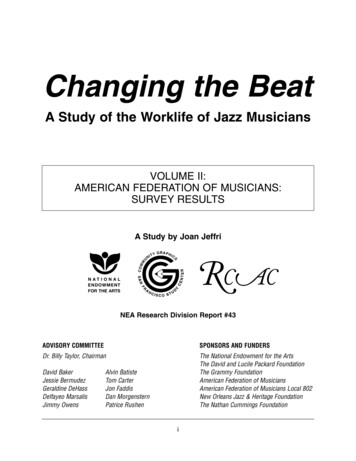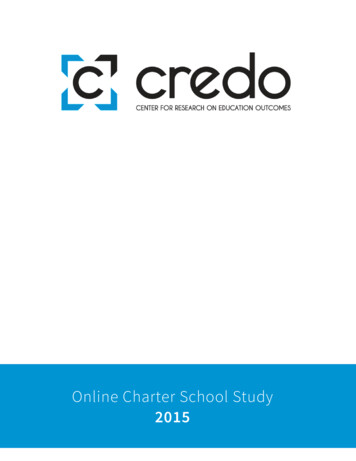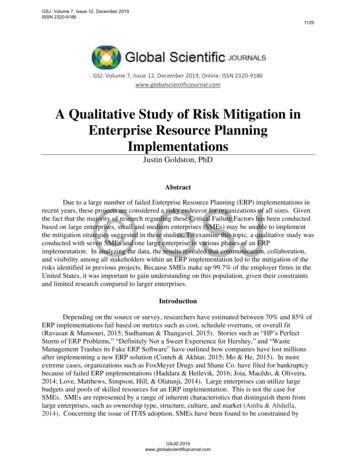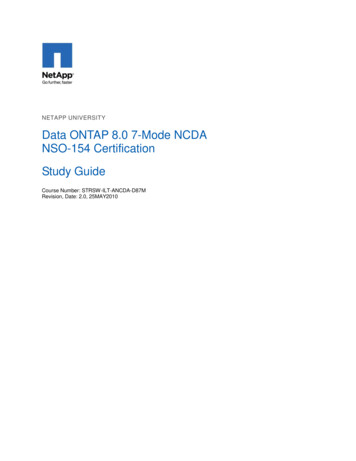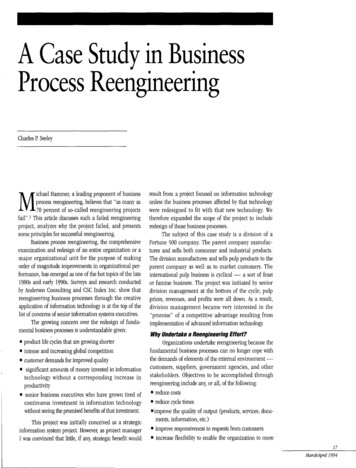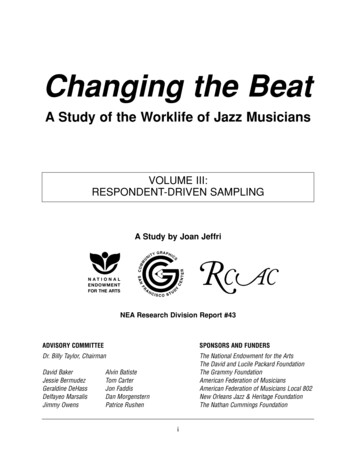
Transcription
Changing the BeatA Study of the Worklife of Jazz MusiciansVOLUME III:RESPONDENT-DRIVEN SAMPLINGA Study by Joan JeffriNATIONALENDOWMENTFOR THE ARTSNEA Research Division Report #43ADVISORY COMMITTEESPONSORS AND FUNDERSDr. Billy Taylor, ChairmanThe National Endowment for the ArtsThe David and Lucile Packard FoundationThe Grammy FoundationAmerican Federation of MusiciansAmerican Federation of Musicians Local 802New Orleans Jazz & Heritage FoundationThe Nathan Cummings FoundationDavid BakerJessie BermudezGeraldine DeHassDelfayeo MarsalisJimmy OwensAlvin BatisteTom CarterJon FaddisDan MorgensternPatrice Rusheni
Project Director:Joan Jeffri, Director, Research Center for Arts and CultureTeachers College Columbia UniversityConsultants:Dr. Douglas Heckathorn, Cornell UniversityDr. Robert GreenblattProject coordinators:Adina WilliamsPhillip HarveyProject researchers:Judith HellmanJanine OkminData consultants:Oscar TorresJudith RosensteinCity Coordinators:DetroitDr. Bernard BrockDr. David MagidsonCenter for the Study of Art and Public PolicyWayne State UniversityNew OrleansPhilip Dobard, DirectorGraduate Program in Arts AdministrationUniversity of New OrleansNew YorkDr. Martin Mueller, DirectorJazz and Contemporary Music ProgramNew School UniversitySan FranciscoDr. Dee Spencer, Director of EducationSF Jazz OrganizationSan Francisco State UniversityLibrary of Congress info here from Executive SummaryCover:iiCopyright of Photo
Table of ContentsIntroductionPurposeFindingsSurvey Background and MethodOrganization of Report11234Chapter I. DemographicsChapter II. Employment and IncomeChapter III. Other IssuesChapter IV. Social NetworksChapter V. Summary, Conclusions and Recommendations511214862AppendicesA. Metropolitan Areas Used in the StudyB. Metropolitan Areas ContextC. Distribution of ResponsesD. Using the Capture-Recapture Method to Estimatethe Number of Jazz MusiciansE. Resource Directory68686977iii140142
iv
IntroductionPurposesurvey of jazz musicians. This volume focuses on theRDS survey of jazz musicians in three cities. Theresults of the AFM survey can be found in VolumeII, which focuses on jazz musicians in all four studycities.This study aims to support the continuinggrowth and development of jazz and the musicianswho create it. Jazz musicians as a group, however, donot constitute an easy subject for formal study.Indeed, the word “jazz” itself proves difficult todefine. “It cannot safely be categorized as folk,popular or art music,” states the New GroveDictionary of Jazz, “though it shares aspects of allthree.” This study relied on the musicians themselvesto indicate that they played jazz music.To study jazz musicians, it is important tounderstand the idiosyncratic nature of the music. AsA.B. Spellman indicated in his introduction to theNEA publication, American Jazz Masters Fellowships1982-2002, jazz was “built on the discipline ofcollective improvisation which allowed formaximum expression of the individual within thecontext of the group.” The group, however, is oftenan ever-changing one. Unlike classical music, withorchestral members staying together for decades, oreven rock, where more often than not musiciansmake their music as a group, jazz musicians oftenlook for jams or gigs as individuals rather than ingroups. Indeed, a jazz group like the Modern JazzQuartet is remarkable for its longevity as much as itsmusic.Working as an individual musician can be moretrying financially, in many ways, than working as agroup. This seems especially true in a musical formthat, while critically acclaimed as a national treasure,does not sell many tickets or CDs. In fact, jazzaccounts for only four percent of annual recordingsales in the United States. It can be even moredifficult for emerging jazz artists to make a livingwith their music; reissues of classic jazz recordingshave consistently outsold all but the most popularcontemporary jazz artists. Even that amount issomewhat inflated by the inclusion of pop artists inthe jazz category.Institutional support for jazz exists but is small.A few state and regional arts agencies and someDeemed a national treasure by the United StatesCongress, jazz is a unique American art form, and itsmusicians, the keepers and producers of thistreasure, are recognized the world over as America’scultural ambassadors. Yet artists who make a livingas jazz musicians face numerous challenges. Despitehigh-profile projects and activities, such as Jazz atLincoln Center’s Essentially Ellington high schoolband competition, the Monterey and other jazzfestivals, or the Jazz documentary by Ken Burns, jazzmusic does not reach as vast an audience as othermusic forms, making it challenging to maintain andcontinue this treasure.Recognizing the importance of jazz and itsartists, the National Endowment for the Arts (NEA)in 2000 commissioned a study of jazz musicians infour U.S. metropolitan areas—Detroit, New Orleans,New York, and San Francisco. The statisticalinformation gathered in the study will be used tohelp devise strategic ways to further the work of jazzartists. These four cities were chosen for theirgeographic diversity and their historical and currentrelationships with jazz. The NEA had two purposes: To understand the environment for jazz ineach of the study cities by documenting both thejazz artists and their resources and support systems. To develop a detailed needs assessment fromjazz artists themselves by collecting datadocumenting their professional lives and mostpressing needs.This study provided an opportunity to examinethe working lives of jazz musicians in a systematicway and to produce quantitative and qualitativeinformation about the jazz community, theprofessional lives of jazz musicians, and jazz’s placein the music industry.Jazz musician and educator Dr. Billy Taylorformed and chaired an advisory board to guide theproject as it developed. The study also created afocus group of artists, managers, and educators, andnumerous jazz practitioners generously gave theirtime to help advise this project. The study wasconducted in two parts: a survey of musiciansbelonging to the American Federation of Musicians(AFM) and a Respondent-Driven Sampling (RDS)1
to a better understanding of the environment inwhich jazz musicians operate. By presenting a clearerpicture of the working life of the jazz artist, thisstudy will help the NEA develop and fund programsthat address the concerns and challenges jazzmusicians face in creating and playing their music.nonprofit foundations offer grants to individualmusicians, but often at low amounts; in this study,of the musicians who received grants, more than 90percent received 5,000 or less. The Lila WallaceReaders Digest Fund and the Doris Duke CharitableFoundation have shored up institutions andendowments of jazz presenters, created networks inthe jazz community, and provided venues for jazzperformance. The National Endowment for the Artshas assisted these organizations with some of theirprograms—such as the joint program with the DorisDuke Charitable Foundation called JazzNet, whichfurthers jazz creation, presentation, and educationwith 14 regional jazz presenters. This programended in 1996, when Congress prohibited awardingdirect grants to individual artists, except for creativewriting and honorary awards in the folk andtraditional arts and jazz. The honorary award injazz, the American Jazz Masters Fellowship,specifically sponsors jazz musicians who areestablished and have achieved mastery of their art.Emerging artists have little access to such support.The data obtained through this study are crucialMusicians’ ResponseThe total of 733 responses yielded 300 in SanFrancisco, 264 in New York, 110 in New Orleans and59 in Detroit. The Detroit figures were too small toanalyze here, but a companion volume (Volume II)reports on a parallel survey of 1,963 jazz musiciansin the musicians union in all four metro areas. Also,in Volume I, the Executive Summary, only threecities are analyzed: New Orleans, New York and SanFrancisco.Findings The top instruments played by jazz musicians are piano/keyboard, drums, bass and voice. 51.5 percent of the respondents earned their major income as musicians in the last 12 months andfor 70 percent, this income came from work as a jazz musician in 2000. While 92.1 percent of the respondents played jazz for money during the last 12 months, 91.2 of therespondents earned 40,000 or less as a musician in 2001. No one earned over 100,000. 63 percent have more than one job, 24 percent of those as music teachers. 79.5 percent play 10 different musical jobs per month and 41.2 percent play with more than fourdifferent groups 37.5 percent have a college degree and another 18.3 percent have a graduate degree. 27.7 percent like the exposure from people downloading their music from the Internet; 24 percentthink they should be paid for this. 69.9 percent of these respondents do not belong to the AFM; 19.4 percent of this group belonged ata previous time. 80.8 percent received music-related training in the city or region where they now reside. The highestwas New York (83.1 percent) 63.3 percent have health or medical coverage; this is lower than the national average of 87 percent. 33.3 percent have life insurance with a high of 43.9 percent in New York. 43 percent have retirement plans with a high of 47.6 percent in New Orleans. 73.1 percent are satisfied or very satisfied with their music at this point, but only 52.5 percent feeltheir career aspirations have been realized. 80.2 percent are male; 59.8 percent are white; 27.8 percent are black.2
SURVEY BACKGROUND ANDMETHODHave you performed in/with a jazz band at least10 times in the last year?Have you performed with or without a jazzband for pay at least 10 times during the last year?Have you produced a documented body of work(documented output performances, compositions,collaborations, arrangements, recordings) that isconsidered (self or externally) jazz?We also asked several different definitionalquestions in the body of the survey.We used a method called respondent-drivensampling (RDS), which was created by sociologistDouglas Heckathorn from Cornell University toidentify hard-to-find populations. Our study samplewas composed of 733 musicians in Detroit, NewOrleans, New York and San Francisco. This methodrequires a high contact pattern among participants,and offered a modest financial incentive for jazzmusicians to recruit each other for personal, one-toone interviews. City coordinators and their staff inthe four study cities spent eight months interviewingjazz musicians, recording their answers ontoquestionnaires, and entering the data into aspecially-created computer program. Both thequestions and the survey design allowed us to learnabout the network patterns of jazz musicians andanswer questions about their social relationshipswith each other.How to identify jazz musicians?There are a wide variety of interpretations as towhat constitutes a jazz artist. Stanley Crouch in“Blues to Be Constitutional” defined jazz artists thisway:No matter what class or sex or religion or race orshape or height, if you can cut the mustard you shouldbe up there playing or singing or having yourcompositions performed. (In O’Meally, R., The JazzCadence of American Culture, 164-5.)Researchers who study artists, as much as theymight enjoy it, would be hard pressed to locate andidentify them by the criterion of cutting themustard. And indeed, as Paul Berliner tells us inThinking in Jazz:Art worlds consist not only of their most seasonedand single-minded members, but of a large supportsystem made up of individuals with different interestsand varying degrees of talent and knowledge.(p. 7)Normally, independent studies of artists rely oninformation from the U.S.Census or organizationallists. The census, while it provides systematicinformation over time, has limitations on the ways itdefines artists and, thus, is often not useful for thearts community. Neither the census nor the CurrentPopulation Survey (Bureau of Labor Statistics) canprovide any breakdown of the broad category of“musicians and composers.”Organizational lists were seen as unrealistic forthe most part, since large numbers of jazz musiciansdo not tend to join organizations. Additionally, jazzmusicians perform substantial work in the for-profitsector, perhaps more than the non-profit sector, fororganizations not often willing or able to generatelists of artists.With the help of a focus group of jazz artists,educators and managers, we created this set ofdefinitional criteria:Do you consider yourself a jazz musician?Did you earn more than 50 percent of yourpersonal income in the last six months as a jazzmusician or in jazz-related activities?Have you been engaged in your art/jazz morethan 50 percent of the time during the last year?Respondent Driven SamplingRespondent driven Sampling (RDS) is a newform of chain-referral sampling developed toovercome the biases traditionally associated withthis method. It has also served as the recruitmentmechanism for an intervention that targets activeinjection drug users for HIV prevention andservices, and has been adapted to a variety of otherpopulations including young gay Latinos in Chicagoand Vietnam draft dodgers in Canada. This is thefirst time it has been used for artists. Perhaps thegreatest benefit of this method is that instead ofreaching only the most visible, vocal, loudest artists,RDS gets deep into the community, like thespreading roots of a tree.Also, RDS, by following the pattern of couponredemption, can discover the networking aspects ofjazz musicians—who hangs out with whom, andwhether they do so by musical type, geography,3
training, family dynasties, etc. Finally, for the firsttime in artist surveys, using the capture-recapturestatistical analysis, we have been able to answer thequestion “How many artists?” in three of the fourstudy cities. (See Appendix for the capture-recapturemethod used to achieve this.)RDS is a method based on peer recruitment. Ineach of the four metropolitan areas. (See Appendixfor metro areas), a city coordinator began the studyby inviting six to eight jazz musicians to help startthe project. These musicians were well-connected inthe community, not necessarily famous or veryvisible, but with many contacts since RDS dependson a high contact pattern of the subjects studied.Each of these musicians was interviewed in personwith questions on an identification sheet whichincluded the selection criteria mentioned above,followed by a 116-question questionnaire. Theinterviews took place in a friendly environmentsometimes donated by a jazz venue (in New York,interviews were held at Sam Ash Music; in SanFrancisco at SF JAZZ; in Detroit and New Orleans,at university facilities). Following the interview, eachof these six to eight “seeds” was given four couponswith which to recruit additional jazz musicians.Three coupons (colored green) could be used forany jazz musician; one of the four coupons (pink)was to be used only for a female jazz musician. (Wetook this approach because we were concerned thattoo few women would be represented in the study.Any skewing was accounted for in statisticalweighting when the data were analyzed.Interestingly, in New York, an organization calledInternational Women in Jazz took advantage of thisopportunity and championed the study and itsrecruitment efforts.)We paid the initial “seeds” a modest 10 and foreach coupon the seed gave out, another 15 eachtime one of the four coupons was redeemed. Anysingle jazz musician had the possibility to earn atotal of 70. This limit on both coupons andpayment incentives was to avoid over-representingone particular group of musicians to the exclusionof others. This incentive had two purposes: first, torecruit other musicians and, second, as anindication to the subjects that their time and theirstories were valued.Traditionally in RDS studies, it takes only four“waves” of coupons to reach deep into thecommunity. In this study, we found some behaviorunique to jazz musicians and to each community.First, our assumption that jazz musicians have ahigh contact pattern because they “hang outtogether” is only partially true—they DO hang outtogether, but as the data show, it is often by musicalstyle that they do so. This pattern was also revealedin a study from the mid-1990s in France called, LesMusiciens de Jazz en France by Philippe Coulangeon(L’Harmattan), which showed that both geographyand differences in style tended to separate Frenchjazz musicians.Second, the “lone wolf ” syndrome often adoptedby jazz musicians makes them somewhat leery ofcollaboration since it is such a hard scramble fortheir next gig. Some of our city coordinators wereextremely inventive in this regard—-going to jazzclubs, festivals and events, speaking about the studyat jazz gatherings, instrument and record stores, atjazz schools and programs—and were vigilant atreminding subjects about interview appointments,rescheduling people who had out-of-town gigs, etc.Third, some reacted negatively to the small paymentincentives. Fourth, coupons were sometimes lost orforgotten, often despite the best intentions of themusicians. But perhaps the most interesting findingwas the musicians’ deep desire to tell their storiesand to be heard.Organization of ReportThe report is organized in five sections,presenting findings on demographics, employmentand income, a variety of professional issues, andsocial networks. It also contains a summary, withconclusions and recommendations. Appendicesinclude definitions and contexts for each metro areastudied, a distribution of responses, the respondentidentification form, an explanation of the methodused to estimate the number of jazz musicians and adirectory of resources for jazz musicians in eachmetro area.4
Chapter I. Demographics*Gender, Age, RaceBoomers.Forty-two percent are single; 26 percent aremarried. In San Francisco over half (51 percent) aresingle.Eighty percent of jazz musicians are male and20 percent are female. The m4ean total age is 43; themedian is 42. New York musicians are a little older:46 is the mean and 47 the median. Surprisingly, inNew Orleans 73 percent of the jazz musicians arewhite.The racial breakdown for jazz musicians in thethree cities is 60 percent white, 28 percent black, 3percent Latino and 3 percent Asian. In New Orleans,the findings are a bit surprising with 73 percentwhite, 23 percent black, 3 percent Asian and noLatino jazz musicians in this study. In New York, 55percent are white, 33 percent are black, 3 percentLatino and 1 percent Asian; and in San Francisco, 59percent are white, 25 percent are black, 3 percent areLatino and 4 percent are Asian.When age is broken out by groups, both the 2534 age group and the 45-54 age group seem toaccount for about half the musicians in total,corresponding mostly to Gen-X-ers and BabyEducationTo help us follow the early musical developmentof survey respondents, a number of questionsregarding their early education and training wereasked. When asked where they were first inspired bymusic, 37 percent of total musicians said theyreceived their initial inspiration at home. Thisreached a high of 47 percent for New Yorkmusicians. Forty-one percent of the totalrespondents received most of their encouragementfrom their families. This was true of 35 percent inNew York, possibly indicating the commonality ofextended families. While 38 percent of the totalrespondents received encouragement from othermusicians, 50 percent of New Orleans areamusicians did.Where did you first get inspired by music?TotalChurchCommunity centerFestivalFilmFriendsHomeNew OrleansNew YorkSan 29.1%47.1%31.2%*The confidence level for this survey is 95 percent with a 5
NEA publication,American Jazz Masters Fellowships 1982-2002, jazz was “built on the discipline of collective improvisation which allowed for maximum expression of the individual within the context of the group.” The group, however, is often an ever-changing one. Unlike classical music,
